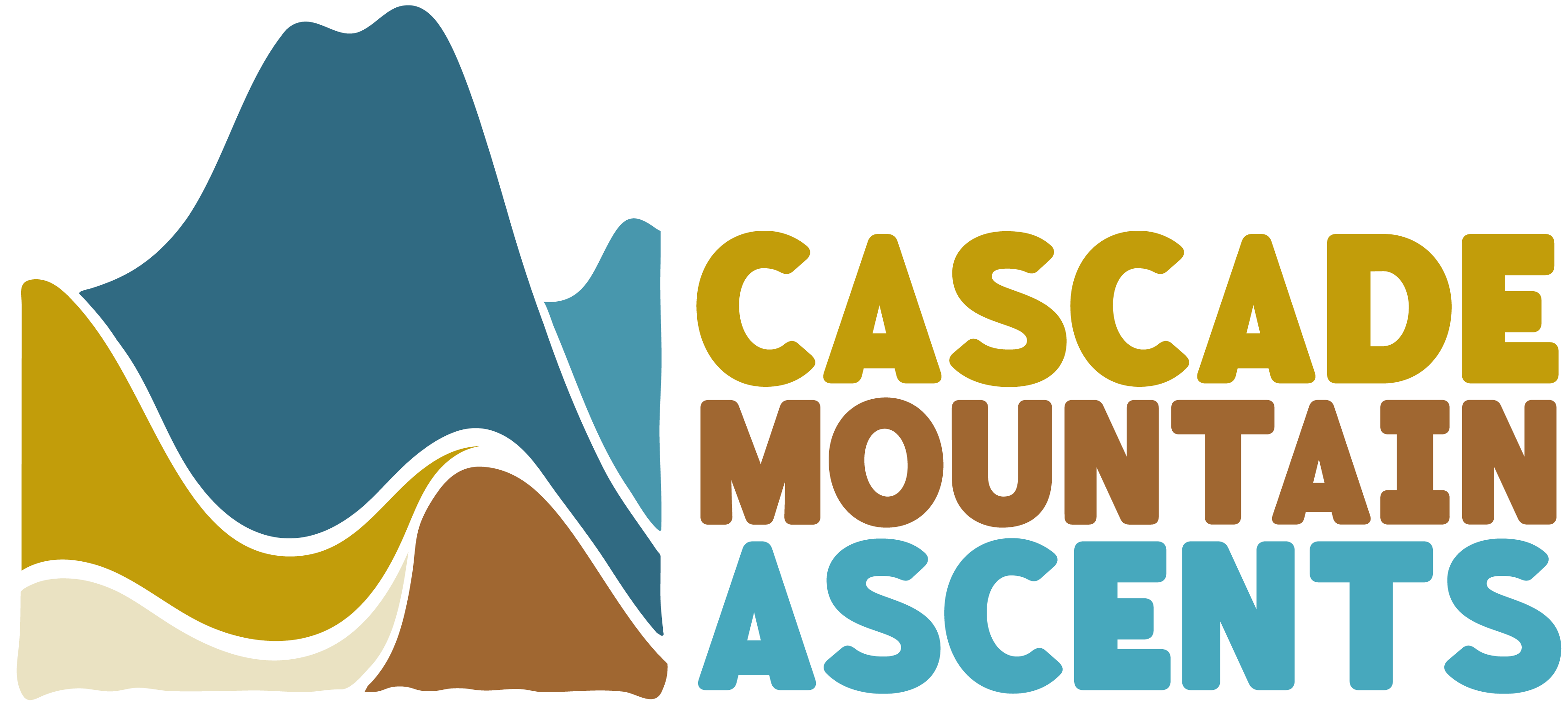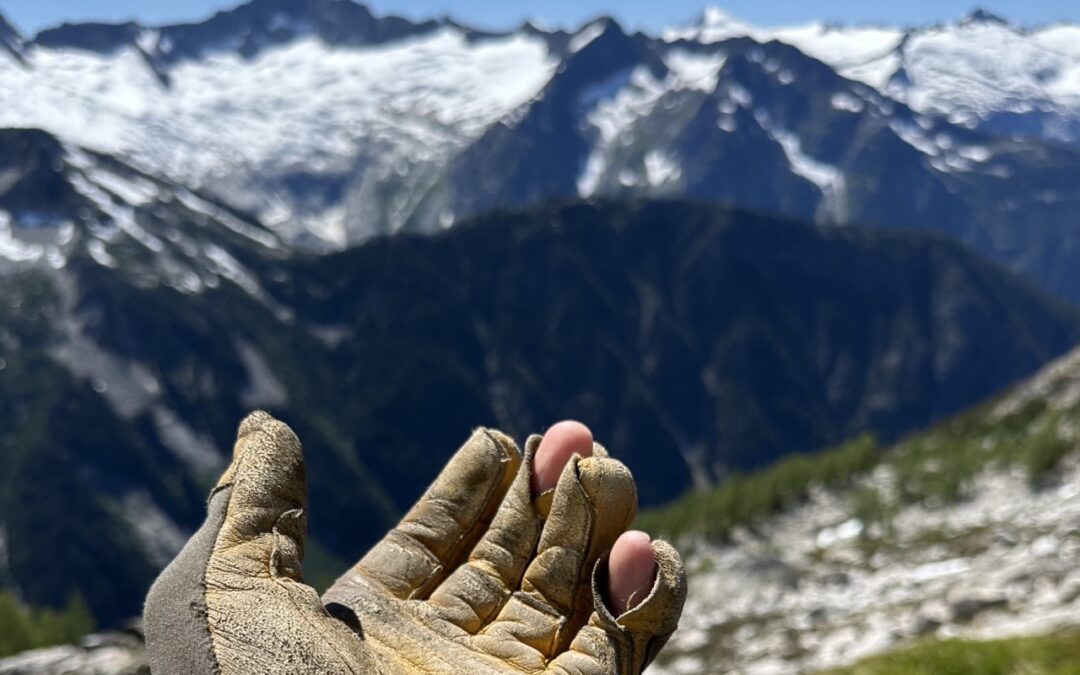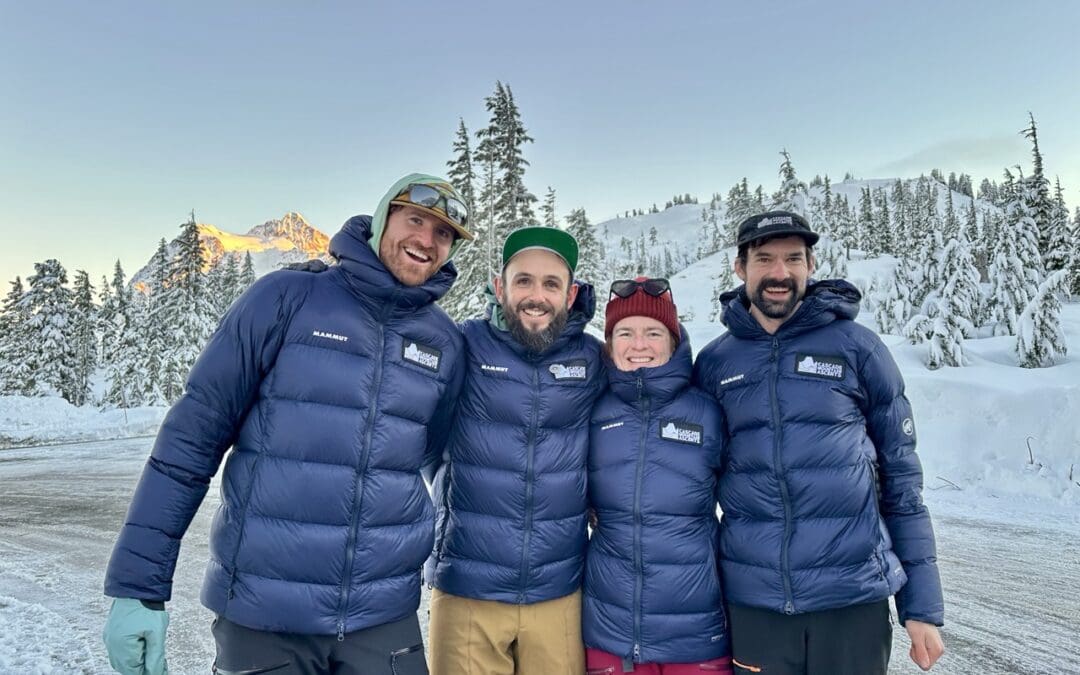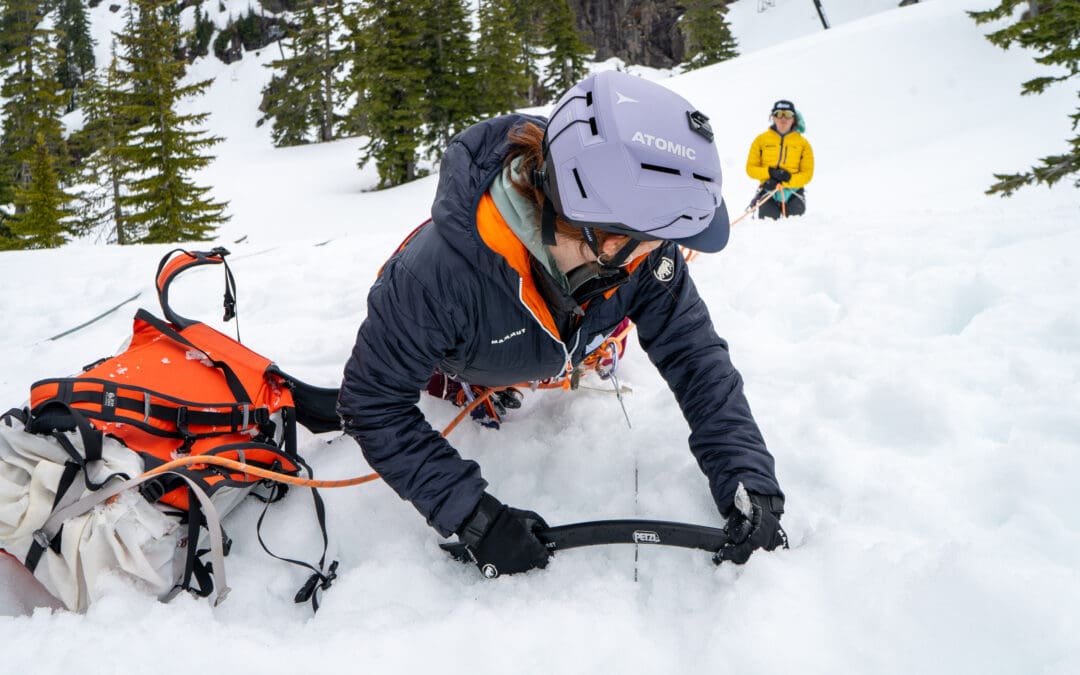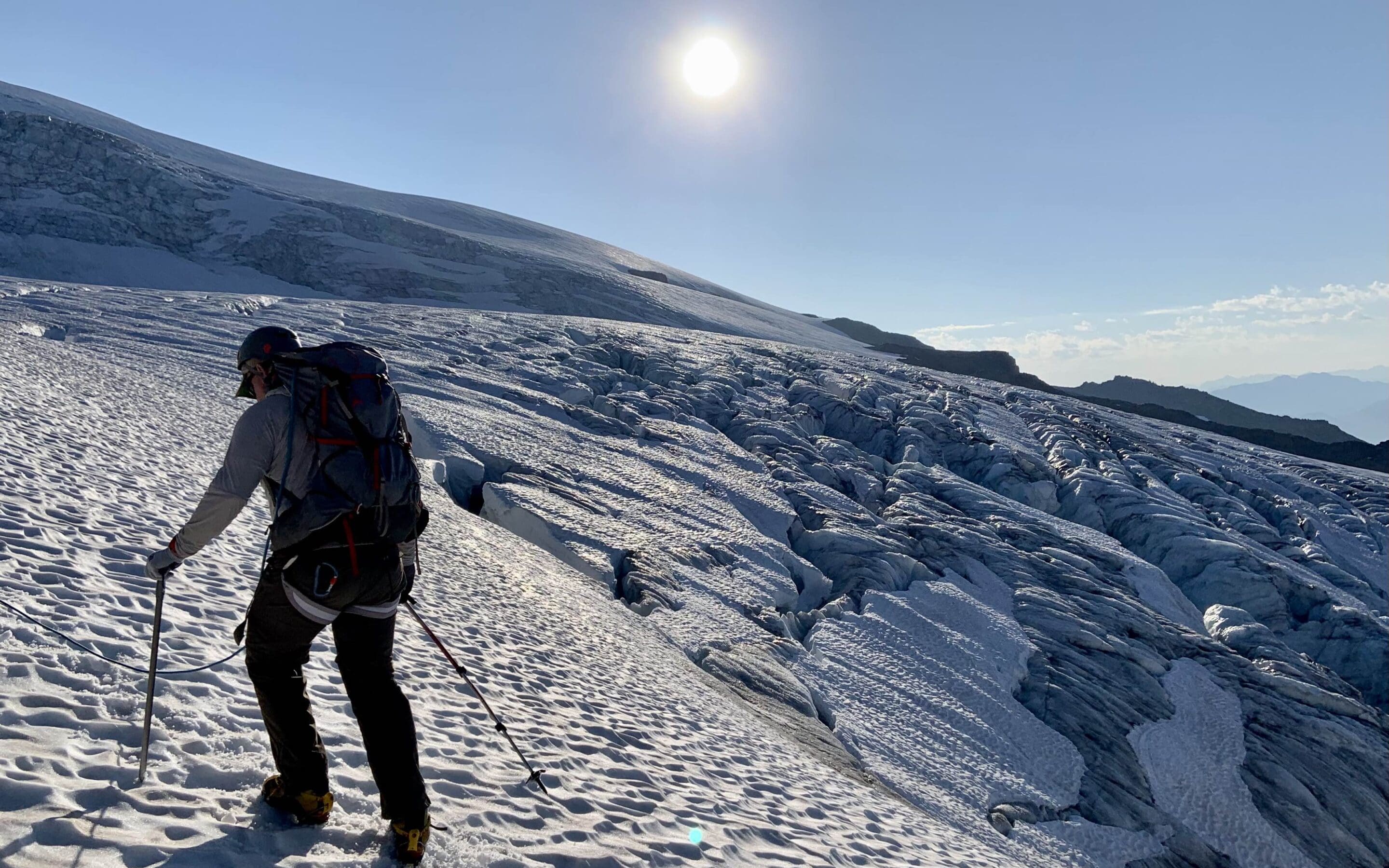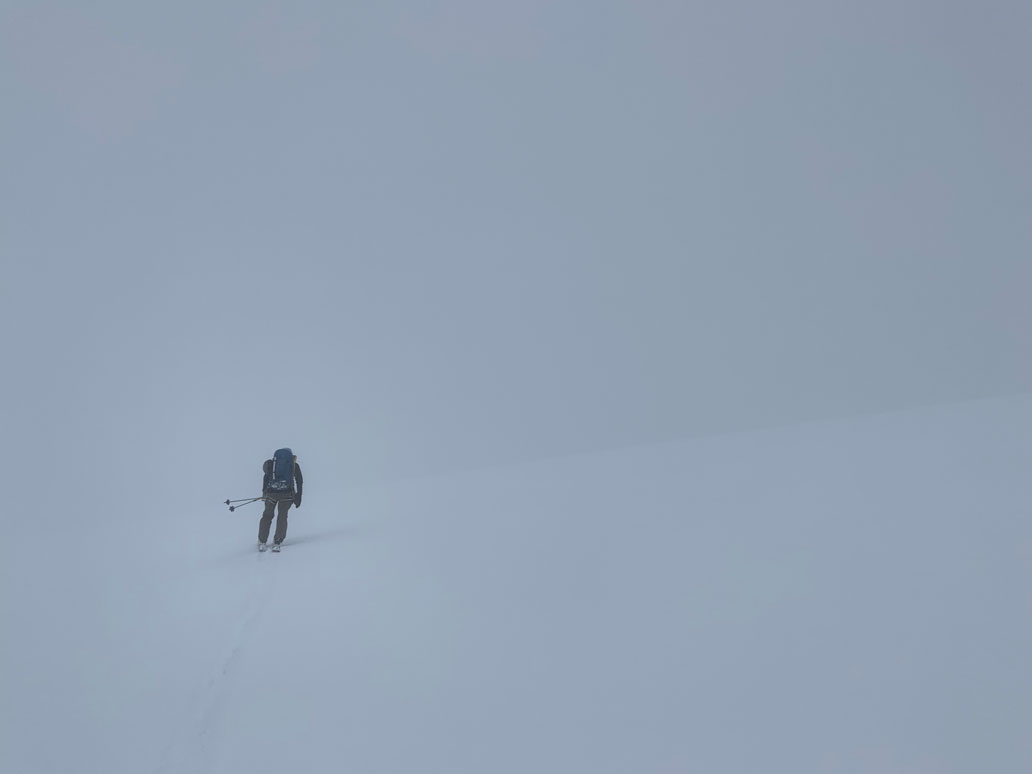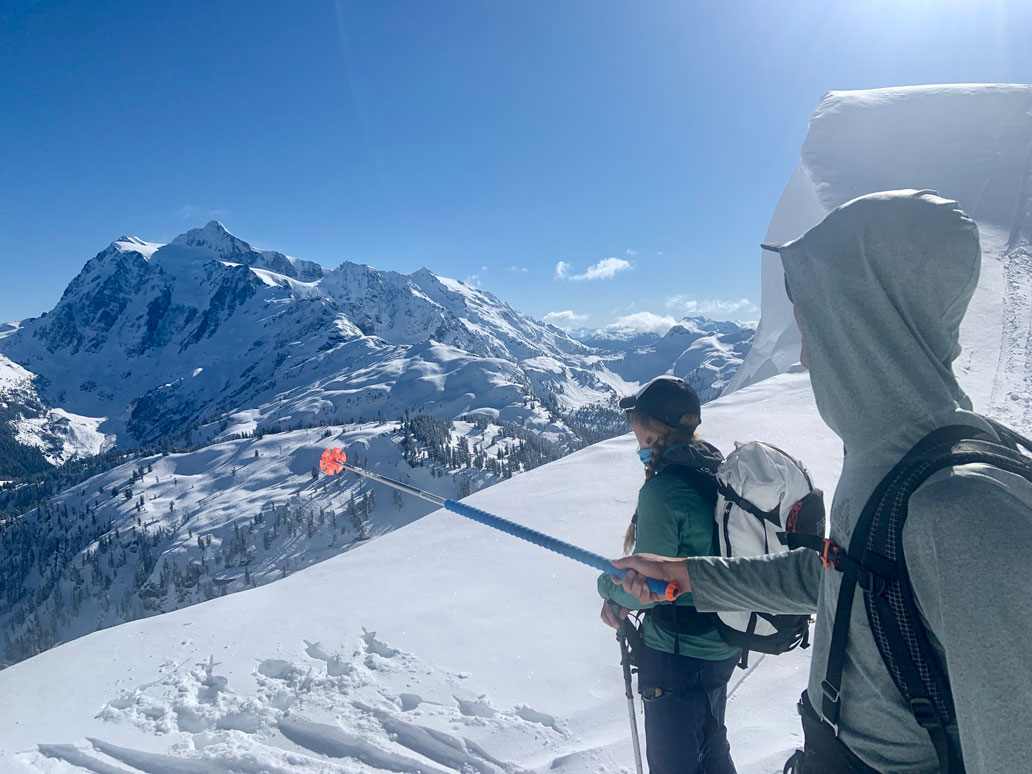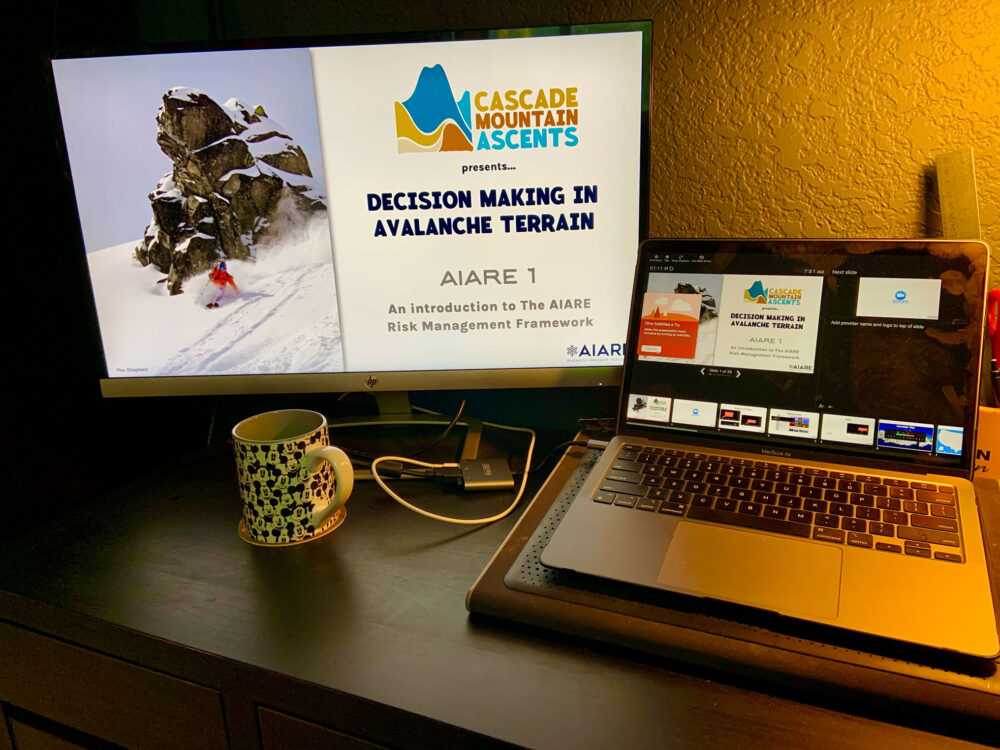Snow Algae
By Ellie Ryan
Pink snow? Watermelon Snow? Snow Algae? Whatever you choose to call this microscopic organism, if you’ve spent time in the PNW alpine, you’ve likely stumbled across a bloom at one point or another. Snow algae blooms can be spotted throughout the Mount Baker Wilderness in the late spring/summertime and provide a startling red contrast against the white snow. Places like Bagley Basin, Artist’s Point, and even the Mazama Glacier high up on the flanks of Baker are home to the algae (fun fact – you can see the Mazama Bloom from SPACE, kind of), whose reach extends as far north as Greenland and as far south as Antarctica.
Photo: Khan lab field crew collecting snow samples on the Rainbow Glacier on Mount Baker (photo credit: Mauri Pelto)
I grew up in the Central Oregon Cascades and mistakenly attributed the reddish stain on alpine snow to minerals found in Oregon lava rock. It was only this past year when I learned that I was actually looking at a single-celled creature and since then, I’ve devoted more time than I’d like to admit to studying it. For the curious citizen scientists out there looking to learn more about this funky microbiota, you’ve come to the right place. The purpose of this resource is to give you the rundown on:
- What snow algae are.
- Where you can find snow algae.
- Why we should care about snow algae.
- How you can get involved with ongoing local snow algae research.
The What
Why ~snow~ algae?
Snow algae thrive in cold, frozen environments. They are cryophilic; “cryo” = extreme cold, and “philic” = loving. So, just like those of us who are passionate about skiing, ice climbing, or spending time in the alpine in any capacity, snow algae love the snow. And they need frozen or near-frozen conditions in order to survive. Why? Great question. Cryophiles as a whole have adapted to frozen environments by developing molecular structures uniquely suited to live in or on snow and ice. A snow algae cell specifically has developed specific pigments (to reflect intensified sunlight), reinforced itself with extra thick cell walls (effective layering!), and insulated itself with fatty acids and lipid bodies (think seal blubber) in order to make snow a suitable habitat. Since it has done such a good job adapting to a cold environment, snow algae has diverged from its other algal relatives and can no longer survive in temperate climates.
A Cellular Breakdown
Snow algae are microscopic, photosynthetic, single-celled organisms. They need sunlight to grow and reproduce, and can hibernate for long periods of time when growing conditions aren’t ideal. As mentioned above, snow algae have developed structurally to combat the cold temps of their environment. Here’s a breakdown of each adaptation:
- Pigments
One odd thing about snow algae is that they are a photosynthetic organism, but they aren’t green (or at least not the snow algae we see on the surface of snow in the PNW). In fact, most surface snow algae here are red, pink or orange. This is because they produce photoprotective pigments that act almost like sunscreen to protect the cells from intense amounts of sunlight. Imagine spending a day on a glacier without sunscreen; we all know (likely from one bad experience) that the high alpine is NOT a good place to forget sun protection. The sun is incredibly potent in snowy, alpine areas due to the reflectivity of snow and thinner atmosphere, so snow algae have developed a way to combat this. The pigment most essential in protecting the algae from sun, and most relatable to sunscreen, is astaxanthin. Astaxanthin is bright red, and is what gives snow algae its characteristic red hue.
- Extra thick cell walls
Think, like, really thick. This is another defense mechanism against crazy high levels of solar radiation. Most of the time I spend in our research lab is spent breaking down this cell wall (which is much, MUCH, harder than you would think).
Photo: Snow algae cell under a fluorescence microscope (photo credit: Alyssa Tsukada)
- Fatty acids and lipid bodies
There are several reasons a snow algae cell would have increased amounts of lipid bodies compared to that of a freshwater algal cell. Like us, these “fats” insulate the cells from cold and serve as energy reserves. Astaxanthin also accumulates in these lipid bodies, which protects the chlorophyll centers (where photosynthesis takes place) from excess sunlight.
Life Cycle (??)
This remains a bit of a mystery, hence the question marks. Some scientists think the algae are blown over and deposited on the surface of snow in the spring via wind. The most widely accepted hypothesis is that the algae are dormant through the winter and, once temperatures are high enough to introduce liquid water into the snowpack, the algae switch into their growing state, turn green, grow flagella (little tentacles) and swim to the top of the snowpack. Once there, they grow and divide in this green state until the sunlight becomes too intense, and then they assume their red, photoprotective state. In the fall, it snows over the top of the algae, and the cycle repeats itself.
The Where
Okay, so now you know a bit more about snow algae and, like me, you’re hooked. You want to go see this spectacle in real life. Where do you go? The good news is that if you live near the Cascade range, especially if you live in Bellingham, you don’t have to go far. For the past several years, from late-May to late-June, our lab has collected samples of snow algae in Bagley Basin, near the Heather Meadows Backcountry Lot off of Hwy 542. To access this bloom, you don’t have to do much more than park at the backcountry lot and hike down into the basin, where the Bagley Lakes are. For the slightly more ambitious hiker, try your luck visiting Camp Kiser off the Ptarmigan Ridge Trail on Mount Baker in early August. And for the (experienced!) mountaineer wanting to witness an epic bloom, the Mazama Glacier is home to an impressively vivid red mat of snow algae in mid-to-late summer (see pic below). For those of you reading this from outside of Washington state, high alpine areas with persistent snowpack are a good place to start. Look for gullies that level out into basins, areas that are south-facing, and areas that may be more nutrient rich (dustier, closer to running water) than others. Or, view this map from the Living Snow Project to see where others have spotted watermelon snow.
Photo: The massive snow algae bloom on the Mazama Glacier, Mount Baker (photo credit: Alia Khan)
Photo: SkySat satellite imagery of the Mazama bloom
Snow algae aren’t just located in the PNW. Like humans, you can find snow algae throughout the globe. In polar regions, some surface snow algae is even green (thanks, penguin poop).
Photo: Red/green snow near a penguin colony in the Antarctic Peninsula (photo credit: Colby Rand)
Why You Should Care
If you’ve seen snow algae in the wild, you may have noticed that little divots and depressions form in the snow around the algae blooms. Snow-covered areas with surface-level snow algae are melting faster than areas without. Snow algae can reduce the albedo of the snow (proportion of incoming light reflected by a surface) by 20% (Healy & Khan, 2023). Because snow is white, it reflects nearly all incoming sunlight, keeping the surface relatively cool. By staining this surface red, more sunlight is absorbed by the snow, causing the surface to warm. The lab I work for is currently trying to assess the impact of snow algae on global snowmelt, using statistical models, satellites/drone imagery, and field sampling to do so.
Graphic: Snow algae (or any pigmented object on the snow) reduce snow albedo (graphic credit: Ellie Ryan)
While, yes, snow algae is contributing pretty substantially in some areas to snowmelt, I do not want to villainize snow algae by saying this. This organism has been around much longer than humans have, and there is a lot that humans are doing (fossil fuel emissions and black carbon, warming temps, increased forest fires… the list goes on) to fuel snowmelt, too. Snow algae largely remain a mystery to us. New species are being discovered on a regular basis and we have so much more to learn about their life cycles, reproductive cycles, growth periods, and environmental influences to their growth, in what feels like a limited amount of time. As glaciers and areas of prolonged annual snowpack recede, so too do opportunities to study this microorganism.
Get Involved/Learn More
- Living Snow Project: https://wp.wwu.edu/livingsnowproject/
- Email me: ryane7@wwu.edu
- Links to other articles:
